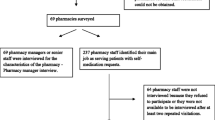Abstract
Objective To investigate the quality and appropriateness of Emergency Hormonal Contraception (EHC) supply from community pharmacies. Setting Community pharmacies in the southwest of England during 2007. Method Two simulated patient (‘mystery shopper’) scenarios to each participating pharmacy, one where the supply of EHC would be appropriate (scenario 1) and one where there was a drug interaction between EHC and St John’s Wort, and the supply inappropriate (scenario 2). Pharmacy consultations were rated using criteria developed from two focus groups: one with pharmacist academics and one with female university students. Feedback to pharmacists to inform their continuing professional development was provided. Main outcome measure Scores on rating scales encompassing the clinical and communication skills of the participating community pharmacists completed immediately after each mystery shopper visit. Results 40 pharmacist visits were completed: 21 for scenario 1 and 19 for scenario 2. Eighteen pharmacists were visited twice. Five pharmacists visited for scenario 2 supplied EHC against professional guidance, although other reference sources conflicted with this advice. Pharmacies which were part of the local PGD scheme scored higher overall in scenario 1 (P = 0.005) than those not part of the scheme. Overall the communication skills of pharmacists were rated highly although some pharmacists used jargon when explaining the interaction for scenario 2. Conclusion Formatively assessing communication skills in an integrative manner alongside clinical skills has been identified as an important part of the medical consultation skills training and can be incorporated into the routine assessment and feedback of pharmacy over-the-counter medicines advice.
Similar content being viewed by others
References
Office for National Statistics. Omnibus survey report no. 37—contraception and sexual health 2007/8. London: The Stationery Office; 2008. ISBN: 978 1 85774 677 8.
Social Exclusion Unit (CM4342). Teenage pregnancy. London: The Stationery Office; 1999.
Bayer Healthcare. Levonelle product website. http://www.levonelle.co.uk/scripts/pages/Page1.php. Accessed 17 Dec 2009.
Marston C, Meltzer H, Majeed A. Impact on contraceptive practice of making emergency hormonal contraception available over the counter in Great Britain: repeated cross sectional surveys. Br Med J. 2005;331:271–5.
Royal Pharmaceutical Society of Great Britain. Practice guidance on the supply of emergency hormonal contraception as a pharmacy medicine. http://www.rpsgb.org.uk/pdfs/ehcguid.pdf. Accessed 17 Dec 2009.
The Pharmaceutical Journal and the Centre for Pharmacy Postgraduate Education. PJ practice checklist: OTC emergency contraception. http://www.pharmj.com/pdf/checklist/EHC.pdf. Accessed 17 Dec 2009.
Department of Health. Implementing the new community pharmacy contractual framework—information for primary care trusts. http://www.dh.gov.uk/en/Publicationsandstatistics/Publications/PublicationsPolicyAndGuidance/DH_4109256. Accessed 17 Dec 2009.
Ferner RE, Beard K. Over-the-counter medicines: proceed with caution. Br Med J. 2008;336:694–6.
Anon. A test of your own medicine. Which? October 2008, pp. 12–4.
Anon. Can your pharmacist cope? Which? February 2004, pp. 10–3.
Anon. Diet drug mis-sold. Which? August 2009, p. 4.
Watson MC, Norris P, Granas AG. A systematic review of the use of simulated patients and pharmacy practice research. Int J Pharm Pract. 2006;14:83–93.
Jesson J. Mystery shopping demystified: is it a justifiable research method? Pharm J. 2004;272:615–7.
Norris P. Reasons why mystery shopping is a useful and justifiable research method. Pharm J. 2004;272:746–7.
Shing MNK, Spence LJ. Investigating the limits of competitive intelligence gathering: is mystery shopping ethical? Bus Ethics Eur Rev. 2002;11:343–53.
Neto A. Changing pharmacy practice: the Australian experience. Pharm J. 2003;270:235–6.
Weiss MC, Locke R, Graham A. Users’ views of new providers of emergency contraception: a qualitative study. Prim Health Care Res Dev. 2007;8:112–20.
French AC, Kaunitz AM. Pharmacy access to emergency hormonal contraception in Jacksonville, FL: a secret shopper survey. Contraception. 2007;75:126–30.
Cohen MM, Dunn S, Cockerill R, Brown TER. Using a secret shopper to evaluate pharmacist provision of emergency contraception. Can Pharm J. 2004;137:28–33.
Anderson C, Bissell P. Using semi-covert research to evaluate an emergency hormonal contraception service. Pharm World Sci. 2004;26:102–6.
Baxter K., editor. Stockley’s drug interactions. 7th ed. London: Pharmaceutical Press; 2006. ISBN: 978 0 85369 624 1.
Joint Formulary Committee. British National Formulary, 54. London: BMJ Publishing Group Ltd and RPS Publishing; 2007. ISBN: 978 085369 736 7.
Alte D, Weitschies W, Ritter CA. Evaluation of consultation in community pharmacies with mystery shoppers. Ann Pharmacother. 2007;41:1023–9.
Benrimoj SI, Werner JB, Raffaele C, Roberts AS. A system for monitoring quality standards in the provision of non-prescription medicines from Australian community pharmacies. Pharm World Sci. 2008;30:147–53.
Benrimoj SI, Werner JB, Raffaele C, Roberts AS, Costa FA. Monitorign quality standards in the provision of non-prescription medicines from Australian community pharmacies: results of a national programme. Qual Saf Health Care. 2007;16:354–8.
Kurtz S, Silverman J, Benson J, Draper J. Marrying content and process in clinical method teaching: enhancing the Calgary-Cambridge Guides. Acad Med. 2003;78:802–9.
Stone M. What patients want from their doctors. Br Med J. 2003;326:1294.
Acknowledgements
The authors gratefully acknowledge the contribution of Mr. Solomon Lai to the conduct and analysis of this research. The authors would also like to thank all the community pharmacists, university staff and university students who participated in this research.
Funding
This project was funded by a small grant from the University of Bath.
Conflicts of interest statement
None.
Author information
Authors and Affiliations
Corresponding author
Rights and permissions
About this article
Cite this article
Weiss, M.C., Booth, A., Jones, B. et al. Use of simulated patients to assess the clinical and communication skills of community pharmacists. Pharm World Sci 32, 353–361 (2010). https://doi.org/10.1007/s11096-010-9375-z
Received:
Accepted:
Published:
Issue Date:
DOI: https://doi.org/10.1007/s11096-010-9375-z




